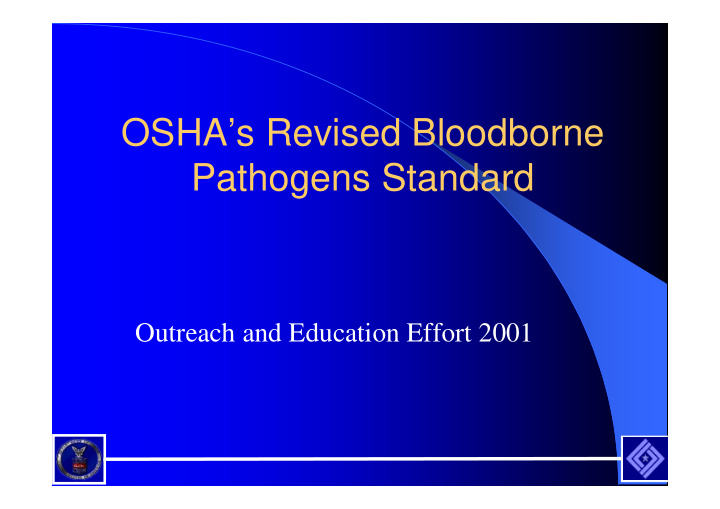



OSHA’s Revised Bloodborne Pathogens Standard Outreach and Education Effort 2001
Bloodborne Pathogens Standard 29 CFR 1910.1030, Occupational Exposure to Bloodborne Pathogens Published December 1991 Effective March 1992 Scope – ALL occupational exposure to blood and other potentially infectious material (OPIM)
Bloodborne Pathogens Standard Major Provisions by Paragraph (b) Definitions (c) Exposure Control Plan (ECP) (d) Engineering and Work Practice Controls - Personal Protective Equipment (PPE) (e) HIV and HBV Research Labs (f) Vaccination, Post-Exposure Follow-up (g) Labeling and Training (h) Recordkeeping
Methods of Compliance Universal Precautions Engineering and Work Practice Controls Personal protective equipment Housekeeping
Since 1991… Advancements in medical technology September 1998, OSHA’s Request for Information (RFI) – Findings of RFI Union and Congressional involvement November 1999, CPL 02-02-069
Needlestick Safety and Prevention Act, P.L. 106-430
The Needlestick Safety and Prevention Act mandated… OSHA clarify and revise 29 CFR 1910.1030, the Bloodborne Pathogens Standard
Needlestick Safety and Prevention Act Timeline P. L. 106-430 signed; November 6, 2000 Revised Standard published in Federal Register; Jan. 18, 2001 Effective date; April 18, 2001 Enforcement of new provisions; July 17, 2001 Adoption in OSHA state-plan states; October 18, 2001
Revisions to Standard Additional definitions, paragraph (b) New requirements in the Exposure Control Plan, paragraph (c) Solicitation of input from non-managerial employees, paragraph (c) Sharps injury log, paragraph (h)
Additional Definitions 1910.1030(b) Engineering Controls - includes additional definitions and examples: – Sharps with Engineered Sharps Injury Protections - [SESIP] – Needleless Systems
Engineering Controls New Definition “… means controls (e.g., sharps disposal containers, self-sheathing needles, safer medical devices, such as sharps with engineered sharps injury protections and needleless systems) that isolate or remove the bloodborne pathogens hazard from the workplace.”
Needleless Systems New Definition Device that does not use a needle for: – Collection of bodily fluids – Administration of medication/fluids – Any other procedure with potential percutaneous exposure to a contaminated sharp
“SESIP” New Definition Non-needle sharp or a needle with a built-in safety feature or mechanism that effectively reduces the risk of an exposure incident.
Hypodermic syringes with “Self-Sheathing” safety feature Self-sheathed protected position
Hypodermic syringes with “Retractable Technology” safety feature Retracted protected position
“Self-Blunting” safety feature Phlebotomy needle with Blunted protected position
Attached to syringe needle “Add-on” safety feature Attached to blood tube holder
Retracting lancets with safety features Before During After Before During After In use After use
Disposable scalpels with safety features Retracted position Protracted position Protracted position
Additional Information About Safety Devices Available At… www.med.virginia.edu/~epinet www.tdict.org Examples of two sources
Exposure Control Plan: 1910.1030(c) New Provisions The ECP must be updated to include: changes in technology that reduce/eliminate exposure annual documentation of consideration and implementation of safer medical devices solicitation of input from non-managerial employees
Solicitation of Non-Managerial Employees New Provision Identification, evaluation, and selection of engineering controls Must select employees that are: – Responsible for direct patient care – Representative sample of those with potential exposure
Engineering and Work Practice Controls: 1910.1030(d) Employers must select and implement appropriate engineering controls to reduce or eliminate employee exposure.
“Where engineering controls will reduce employee exposure either by removing, eliminating, or isolating the hazard, they must be used.” CPL 02-02-069
Engineering and Work Practice Controls Selection of engineering and work practice controls is dependent on the employer’s exposure determination.
Exposure Determination The employer must: – Identify worker exposures to blood or OPIM – Review all processes and procedures with exposure potential – Re-evaluate when new processes or procedures are used
Engineering and Work Practice Controls (con’t) The employer must: – Evaluate available engineering controls (safer medical devices) – Train employees on safe use and disposal – Implement appropriate engineering controls/devices
Engineering and Work Practice Controls (con’t) The employer must: – Document evaluation and implementation in ECP – Review, update ECP at least annually – Review new devices and technologies annually – Implement new device use, as appropriate and available
Engineering and Work Practice Controls (con’t) The employer must: – Train employees to use new devices and/or procedures – Document in ECP
Recordkeeping: 1910.1030(h) Sharps Injury Log – Only mandatory for those keeping records under 29 CFR 1904 – Confidentiality – Maintained independently from OSHA 300
Sharps Injury Log At a minimum, the log must contain, for each incident: Type and brand of device involved Department or area of incident Description of incident
Summary of New Provisions Additional definitions, paragraph (b) New requirements in the Exposure Control Plan, paragraph (c) Non-managerial employees involved in selection of controls, paragraph (c) Sharps injury log, paragraph (h)
U.S. Department of Labor, OSHA 200 Constitution Avenue NW, Room N-3603 Washington, DC 20210 (202) 693-2190 Or contact your Regional, Area, or State-Plan Office
Recommend
More recommend